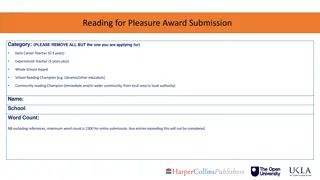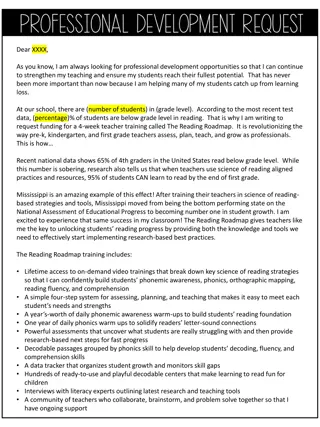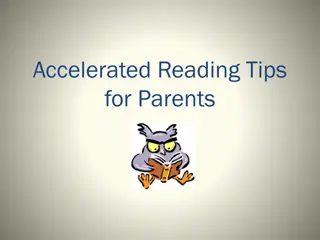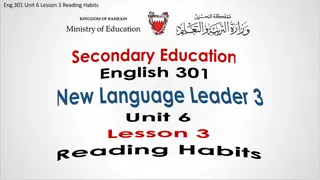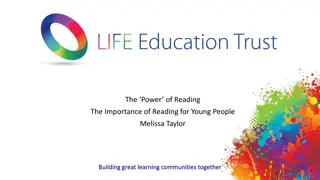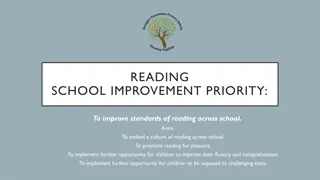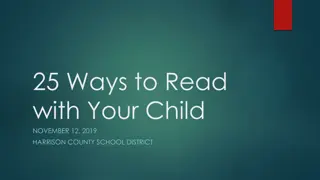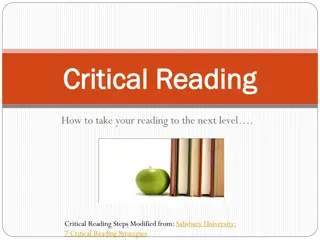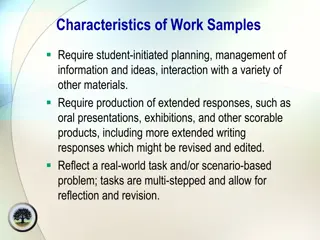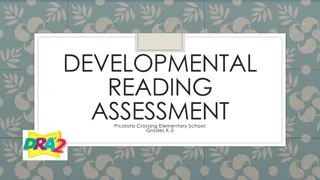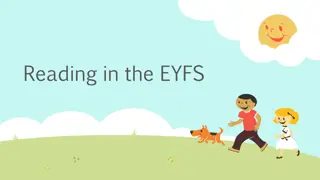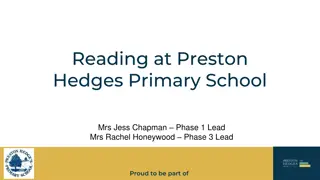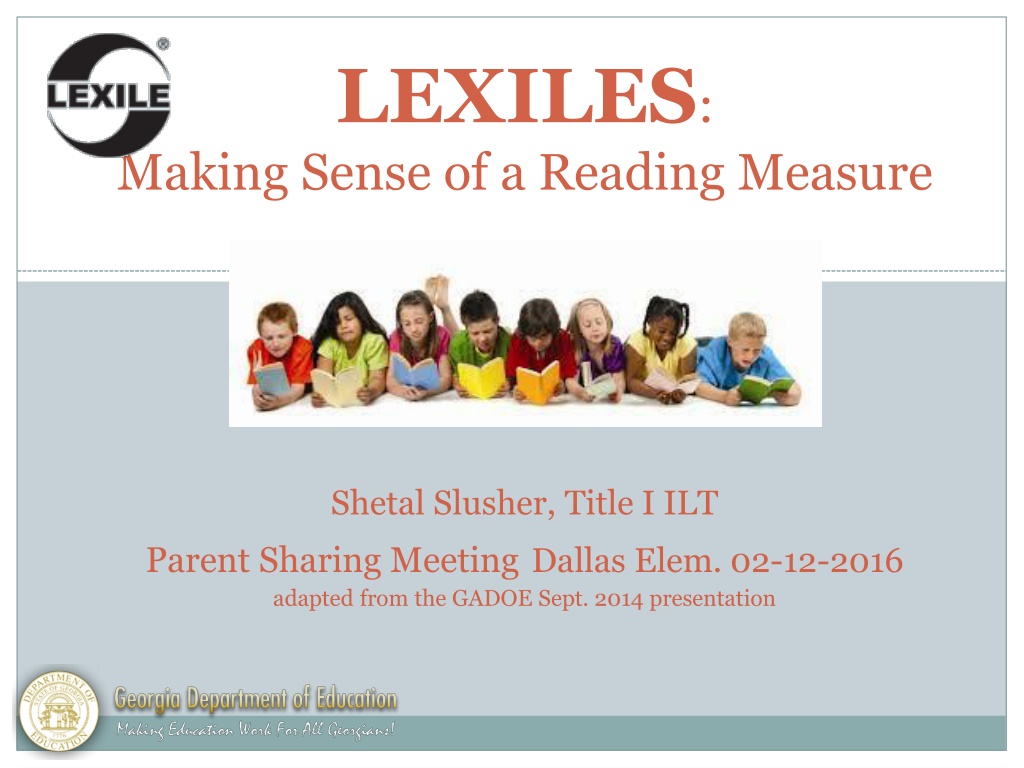
Understanding Lexile Reading Levels in Education
Explore the importance of Lexile measures in determining student reading abilities and text complexity levels. Discover how Lexile ranges, scale, stretch bands, and college-and career-readiness guidelines help track reading growth and ensure students are prepared for academic success.
Download Presentation

Please find below an Image/Link to download the presentation.
The content on the website is provided AS IS for your information and personal use only. It may not be sold, licensed, or shared on other websites without obtaining consent from the author. If you encounter any issues during the download, it is possible that the publisher has removed the file from their server.
You are allowed to download the files provided on this website for personal or commercial use, subject to the condition that they are used lawfully. All files are the property of their respective owners.
The content on the website is provided AS IS for your information and personal use only. It may not be sold, licensed, or shared on other websites without obtaining consent from the author.
E N D
Presentation Transcript
LEXILES: Making Sense of a Reading Measure Shetal Slusher, Title I ILT Parent Sharing Meeting Dallas Elem. 02-12-2016 adapted from the GADOE Sept. 2014 presentation 1
How Reading Levels are Identified Screeners and assessments (DIBELS, IDI, Grade Level assessments, GKIDS, GMA) Comprehensive Reading Solutions Framework (CRS) Four areas of instruction = Interactive Read Aloud (above grade level) Shared Reading (on grade level) Differentiated Foundational Skills (at student s level) Lucy Calkins Writing (writing process)
What is a Lexile Range? Lexile Overview Video Lexile measure refers to: 1) the measure of a student s reading ability based on vocabulary, fluency and comprehension; and, 2) the difficulty level of the text based on word frequency and length of sentences
The Lexile Scale Lexiles typically range from 200 for beginning readers to 1700 for advanced readers Lexile text below 200L represents beginning- reading material. A student s Lexile score may have a number in the 100s or the code of BR (for Beginning Reader). Applies to both reader ability and text difficulty When reader and text measures are the same, the student is expected to read with 75% comprehension. Can be used to track reading growth over time
Lexiles Stretch Bands & College- and Career-Readiness The Lexile Framework has been realigned to match the college- and career-ready text complexity grade bands. The stretch bands of the Lexile Framework show an upward trajectory of reading comprehension development through the grades to indicate that all students should be reading at the college- and career-readiness level by no later than the end of high school. 5
Lexile Bands College & Career Ready Stretch Lexile Bands 190L to 530L 420L to 650L 520L to 820L 740L to 940L 830L to 1010L 925L to 1070L 970L to 1120L 1010L to 1185L 1050L to 1260L 1080L to 1335L 1185L to 1385L Grade 1 2 3 4 5 6 7 8 9 10 11 and 12 These stretch Lexile bands are the basis for determining at what text complexity level students should be reading and at which grades to make sure they are ultimately prepared for the reading demands of college and careers. 6
How will Lexiles be reported? Student Score Report GMA provides: Lexile information in parent-friendly format. Lexile score and Lexile range. An explanation on how to use the information. Sample book titles individualized for each student based on their Lexile range. These are categorized into a Leisure reading range and a Challenging reading range. Lexile information will also be provided in the data files supplied to districts.
How are Lexiles calculated? Semantic Difficulty Word Frequency Syntactic Complexity Sentence Length
Accessing the Find A Book Tool http://lexile.com/fab/GA
Alternate Method The book Betsy s Busy Summer isnot in Lexile database. Other books by Carolyn Haywood are: B is for Betsy 660L Back to School with Betsy 570L Betsy and the Boys 560L If book is in same series, then book is most likely somewhere in this range. Also see what other leveling might be done for the author or series. The reading level for many Betsy books is 9 to 12-year-olds; this translates roughly into 3rd to 5th grade or about 500L to 950L.
Making Connections Using Lexiles HOME LIBRARY SCHOOL The Lexile Framework is a tool for teachers, media specialists, librarians, and parents to use in conjunction with existing reading programs and is not a replacement for existing reading programs.
How to Use Lexiles It is recommended that readers choose texts within their Lexile range. A Lexile range is 50L above and 100L below a student s reported Lexile measure. Selection for pleasure reading should also be based on student s interests Practice with a variety of texts. Use Lexiles to set goals.
Using Lexiles in the Classroom Teachers can use Lexiles to help them: Develop individualized or classroom reading lists tailored to provide appropriately challenging reading. Enhance thematic teaching by building a bank of titles at varying levels that support the theme, but also allows all students to participate successfully in the theme with material at their own reading level. Sequence materials, for example by increasing the difficulty of read-aloud books throughout the year. Source: http://www.lexile.com/m/uploads/downloadablepdfs/Lexiles-in-the-Classroom.pdf
More Instructional Uses of Lexiles Teachers can use Lexiles to: Set measurable goals for instruction and special intervention programs Monitor progress of various reading programs Make parents partners to the classroom by giving them a tool for selecting appropriate reading material for their children (e.g., Summer Reading Lists, visiting library, etc.) Help students set goals for themselves and use annual GMA results to see if they have progressed towards their goals. Source: http://www.lexile.com/m/uploads/downloadablepdfs/Lexiles-in-the-Classroom.pdf
Summer Reading Is Essential! Research studies show that --- students can have up to a 2-3 month loss in reading ability over summer. Plan ahead to avoid issues with accessing books: schedule library visits, ask teacher for summer resources, start a book club/exchange innovative partnering of schools, publishers, and public libraries have great promise for solving the summer reading loss dilemma.
Using Lexiles to Promote Reading Improve students reading fluency and increase enjoyment of reading. Students who spend a minimum of 3 hrs/week reading at their own level for their own purposes develop reading fluency which leads to improved mastery. It is recommended that readers choose texts within their Lexile range. A Lexile range is 50L above and 100L below a student s reported Lexile measure. Use Lexiles to set goals. Practice with a variety of texts. Challenge the BEST readers. Success breeds enjoyment.
Parents Can Use Lexiles Promotes family-school connections. Know your child s Lexile measure. Know your child s Lexile range. 50L above and 100L below their reported Lexile measure. This range represents the boundaries between the easiest kind of reading material for your child and the hardest level at which he/she can read successfully. Use the Lexile Find a Book Database (at http://lexile.com/fab/) to find books in the child s Lexile range. Source: http://www.lexile.com/m/uploads/downloadablepdfs/Lexiles-at-Home.pdf
Parents Can Use Lexiles Build Oral Language Skills! From Birth through Elementary School Speak in complete sentences when asking and answering questions Explain yourself give details, share background info, start a dialogue Build Prior Knowledge / Background Information Watch and read a variety of informational shows/texts Give children research projects (i.e. Google it , take a survey, go ask .) Take Field Trips (real & virtual) and Stay cations
Prior Knowledge Prior knowledge affects how the learner perceives new information. What is the first image that you associate with the word "cardinal"?
Cardinal .football, baseball, birds, Roman Catholic priests, or the color red In the absence of a context, the association you make will depend on your prior knowledge. Your interpretation of this new information, the word "cardinal," was dependent on what you brought to the situation.
Parents Can Use Lexiles Ensure that your child reads every day. Parents should read to set a good example. Reading newspapers and magazines will show children that reading is a wonderful pastime as well as a window to the world of learning. Ask school or library for book lists within Lexile range. Student s interests should play a part in book selection. Visit public libraries often. Participate in summer reading programs. Source: http://lexile.com/m/uploads/downloadablepdfs/Lexiles-at-Home.pdf
Parents Can Use Lexiles When a reading assignment proves to be too difficult, provide adult-directed assistance: Review words and definitions from glossary or dictionary. Review questions at end of chapter before child reads text. Pair-share read Parent and student alternate reading the text. Stop, discuss, and ask questions along the way to see that student understands. Return to end of chapter questions and glossary to make certain your child understands the material. Celebrate your child s reading accomplishments. Set goals number of books read variety of books stretch to books at higher Lexile Source: http://www.lexile.com/m/uploads/downloadablepdfs/Lexiles-at-Home.pdf
Want to Know More . . . GA Department of Education has Lexile information at: http://www.gadoe.org/Curriculum-Instruction-and- Assessment/Assessment/Pages/Lexile-Framework.aspx https://www.georgiastandards.org/Resources/Pages/Tools/LexileFr ameworkforReading.aspx MetaMetrics website: http://lexile.com/ Contact: Dr. Melodee Davis, Director Assessment Research and Development Division Georgia Department of Education Phone: 404-657-0312 Email: medavis@doe.k12.ga.us
Read every day!


